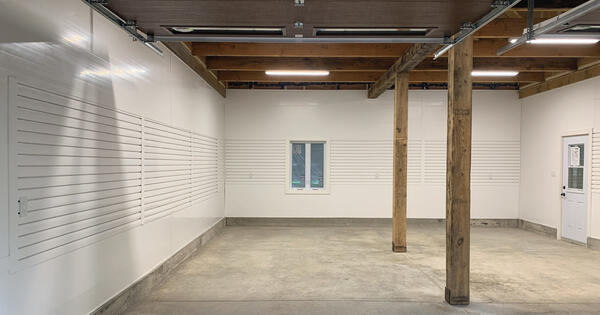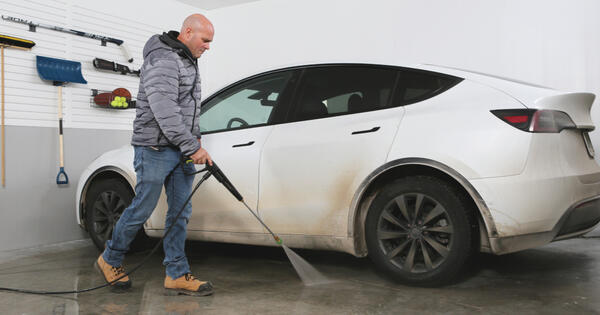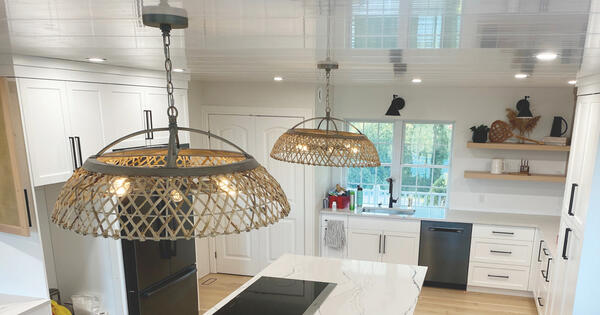This post was originally published in January 2023. Last updated: April 2025.
Before picking a wall material, it’s important to step back and think about how you use — or plan to use — your garage. Not every garage needs high-end finishes or industrial-level durability, but knowing your priorities can help you avoid choosing a material that won’t hold up or suit your needs long-term.
Here are a few key questions to guide your decision:
- How will the space be used? If your garage is mostly for parking and storage, you may not need a wall material that can withstand regular wear and tear. But if you’re setting up a workshop or hobby space, you’ll want something tougher and more versatile.
- Will the walls be exposed to moisture or extreme temperatures? Garages that aren’t climate-controlled can experience big swings in humidity and temperature. That’s where moisture resistance and material stability really matter — especially if you live in an area with cold winters or hot, humid summers.
- Do you plan to hang tools or install shelving? If you need to support weight on the walls — whether that’s heavy-duty hooks, tool racks, or shelving units — strength becomes a top priority. Some materials make this easier than others without the need for extra reinforcement.
Taking stock of these details will help narrow down the material that best fits your space, goals, and climate.
Plywood for Garage Walls
Plywood has long been a go-to choice for garage walls, and for good reason — it’s affordable, easy to work with, and strong enough to handle a variety of tasks. For homeowners who value function over flash, plywood is a reliable, straightforward option that gets the job done.
Here are some of the key advantages and disadvantages to consider:
| Pros | Cons | ||
|---|---|---|---|
| Plywood is strong enough to support heavy tools, shelves, and wall-mounted equipment without needing additional bracing. | Plywood isn’t naturally moisture-resistant, so it can swell, warp, or delaminate in damp or humid environments if it’s not sealed properly. | ||
| It’s widely available and budget-friendly — especially compared to other durable wall materials. | Temperature fluctuations can cause expansion and contraction over time, which might lead to surface imperfections or cracking. | ||
| It can be easily cut, drilled, and installed with basic tools. | It may not offer the clean, polished look some homeowners are after, especially in finished or upgraded garages. | ||
| You can paint or stain plywood to better match your space or seal it for added protection. |
Overall, plywood works best in garages that need strength and flexibility at a lower cost — but it does come with maintenance requirements if moisture is a concern.
PVC Panels for Garage Walls
PVC wall panels offer a more modern, clean-lined alternative to traditional materials like plywood — especially for homeowners who want something that’s both functional and low maintenance. These panels are designed to perform well in demanding environments, making them a smart choice for garages that see a lot of activity, moisture, or mess.
Here’s how PVC panels stack up in a garage setting:
- They’re extremely durable. PVC panels are built to resist impacts, scratches, and wear, so they hold up well whether you’re moving tools, vehicles, or storage bins around.
- Moisture resistance is one of their biggest strengths. PVC doesn’t absorb water, which means it won’t swell, rot, or develop mold and mildew — even in humid or unheated garages.
- Cleaning is quick and easy. A damp cloth or standard cleaner is all it takes to wipe away dust, oil, or grime. There’s no need to repaint, reseal, or refinish over time.
- Some PVC systems let you hang tools and accessories directly from the wall. While not all PVC panels support heavy loads, many — especially those with slatwall-style designs like Trusscore SlatWall — can hold hooks, bins, and brackets when properly installed.
- They typically cost more upfront than plywood. However, that higher initial price often comes with reduced maintenance, a longer lifespan, and fewer repair headaches.
PVC panels are ideal for homeowners who want a bright, polished garage that stays looking good with minimal upkeep.
PVC Panels vs. Plywood for Garage Walls
Let’s have a look at the two products and compare them across different categories.
Aesthetic and Functional Considerations
The way your garage walls look and perform day-to-day can have a big impact — especially if it’s a space you use regularly, whether for work, storage, or simply coming and going.
Here’s how plywood and PVC panels stack up from a design and durability standpoint:
- Appearance and finish:
- Plywood has a rougher, unfinished look by default. You can paint or stain it, but it’ll still show imperfections unless sanded and sealed carefully.
- PVC panels offer a clean, polished appearance right out of the box — often with a bright white or neutral tone that helps reflect light and make the garage feel bigger and brighter.
- Customization potential:
- Plywood is highly customizable. You can paint it any color, mount just about anything to it, or even cover it with other materials.
- Some PVC panels can be painted, but most are designed to be installed as-is. Customization is more about accessories and functionality than altering the look.
- Resistance to daily wear:
- Plywood can chip, dent, or stain, especially if it’s exposed to tools, bikes, or moisture. It holds up well structurally but shows its wear over time.
- PVC panels are far more resistant to grime, scuffs, and damage. They’re easy to wipe down and don’t absorb moisture or odors — which makes a big difference in high-traffic garages.
If aesthetics and long-term cleanliness are priorities, PVC panels offer a more finished and durable solution with less effort.


Cost Comparison
When deciding between PVC panels and plywood, cost often plays a big role — but there’s more to consider than just the price of the materials. Installation effort, maintenance needs, and long-term durability can all affect how much you end up spending over time.
Here’s a breakdown of the key cost factors:
- Upfront material costs:
- Plywood is generally less expensive per sheet, making it the more budget-friendly choice at the start.
- PVC panels come at a higher price point, especially those designed for strength and tool storage — but they also offer built-in moisture resistance and a finished appearance.
- Installation expenses:
- Plywood can be installed with basic tools and fasteners, especially if you’re comfortable with a DIY project.
- PVC panels may require more prep work and precision, particularly if you’re using interlocking or slatwall systems. That said, many homeowners still tackle it themselves.
- Long-term savings:
- Plywood may need sealing, painting, or replacing if it’s exposed to moisture or damage.
- PVC panels don’t require much upkeep at all, so while the initial cost is higher, the maintenance costs are minimal — and you’re less likely to need repairs or replacements down the line.
If you’re only focused on initial costs, plywood wins. But if you’re thinking about what you’ll spend — and save — over time, PVC often comes out ahead in the long run.
Installation and Maintenance Considerations
Installing new garage wall materials doesn’t always require a pro — but some materials are definitely easier for DIYers than others. Knowing what to expect can help you decide which material makes the most sense for your skill level, tools, and timeline.
Let’s look at what’s involved with both options:
- DIY potential:
- Plywood is simple to install for most homeowners. You’ll just need a saw, a drill or nail gun, and some basic measurements.
- PVC panels are also DIY-friendly, especially if they’re tongue-and-groove or slatwall panels designed for easy interlocking. Just be prepared for a bit more planning and precision to keep things aligned.
- Installation time and complexity:
- Plywood goes up quickly — especially on open studs — but may require additional finishing like sanding, sealing, or painting.
- PVC panels may take longer to install depending on the layout and whether accessories (like hanging tracks or trim) are involved, but they don’t require finishing once they’re up.
- Ongoing maintenance:
- Plywood needs occasional care, especially in damp conditions — sealing, repainting, or replacing damaged sections may be required.
- PVC panels are practically maintenance-free. Just wipe them down when needed, and you’re good to go.
In short, both materials can be installed without hiring a contractor, but PVC panels offer the clear advantage when it comes to long-term upkeep and durability.
Environmental and Health Considerations
For many homeowners, it's not just about performance and price — it's also about choosing materials that are safe and environmentally responsible.
Here’s what to keep in mind when comparing plywood and PVC panels:
- Sustainability:
- Plywood is made from wood veneers, which means it comes from natural resources — but it’s often glued with adhesives that may not be eco-friendly.
- PVC is a plastic product, which makes it less renewable. However, some manufacturers — including Trusscore — use recyclable materials and design their panels to be 100% recyclable at end of life.
- Off-gassing and indoor air quality:
- Some types of plywood may emit VOCs (volatile organic compounds) due to the adhesives and resins used in manufacturing — especially if they're not labeled as low-VOC or formaldehyde-free.
- PVC panels are generally low in VOCs, and high-quality options like Trusscore are third-party tested to ensure they meet indoor air safety standards.
- Recyclability:
- Plywood can sometimes be reused or repurposed, but it’s not typically recycled once it's been treated or painted.
- PVC panels, depending on the brand, can often be fully recycled. That makes them a more sustainable option when considering the full product lifecycle.
If health and environmental impact are top concerns, it’s worth asking about VOC certifications and recycling programs before making a final decision.
Why Trusscore Wall&CeilingBoard is the PVC Panel of Choice for Garage Walls
If you’re leaning toward PVC but want something that goes beyond the basics, Trusscore Wall&CeilingBoard is worth a closer look. It’s a PVC-based panel system that combines performance, aesthetics, and versatility — and it’s built specifically for spaces like garages, workshops, and utility rooms.
Here’s why Trusscore stands out:
- It’s stronger than standard PVC panels. Trusscore Wall&CeilingBoard is ½” thick and engineered to be impact-resistant and long-lasting, so it won’t crack, warp, or discolor — even in tough environments.
- It’s moisture and mold resistant. Like other PVC products, Trusscore doesn’t absorb water, making it a great fit for garages that aren’t climate-controlled or are prone to humidity.
- It’s easy to clean. Just wipe it down with a cloth or hose it off — there’s no need for special cleaners, and it won’t stain like painted surfaces can.
- You can mount accessories directly to it. With the help of Trusscore’s complementary SlatWall system, you can hang shelves, hooks, bins, and more on your walls — without damaging the walls or hunting for studs.
- Installation is DIY-friendly. Panels are lightweight and interlock for a seamless fit. You’ll just need basic tools and a bit of planning.
- It looks sharp. The smooth, glossy surface adds a modern, professional feel to any garage, instantly making the space look finished and well-kept.
PVC vs. Plywood: Which Option Is Best for You?
There’s no one-size-fits-all answer when it comes to garage wall materials — it really depends on how you use the space and what matters most to you.
Choose plywood if:
- You’re on a tighter budget.
- You want a DIY solution that’s easy to customize.
- You’re comfortable with some maintenance, like painting and sealing.
Go with PVC panels if:
- You want a clean, polished look with minimal upkeep.
- Moisture resistance and durability are priorities.
- You’re planning to use the garage regularly and want it to stay looking good.
For homeowners looking for the best of both worlds — easy installation, high performance, and great looks — Trusscore Wall&CeilingBoard offers a strong alternative that’s purpose-built for garage environments.
To explore your options in person, check with your local building supply store or visit the Trusscore website for retailer locations and sample kits.



 Source:
Source: 




